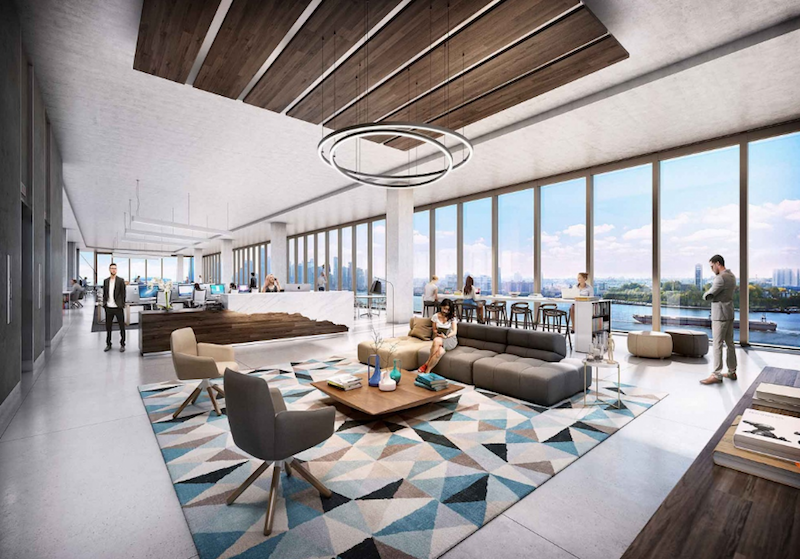When designing a new office building located between Manhattan’s High Line Park and the Hudson River, Studio Gang wanted to protect the views between the park and the river and block as little sunlight as possible. The firm’s solution to this problem was to take on the sun as a freelance designer.
Expanding upon its “solar carving” design strategy, Studio Gang used incident angles of the sun’s rays to sculpt the Solar Carve Tower’s form. The result is a gem-like façade that allows light, fresh air, and river views to reach the park.
At any point during the year, the sun’s rays will be able to pour around the building’s unique façade, which takes the shape of an hourglass made up of smaller diamond-shaped carvings, to reach the surrounding park and green space.
On its website, Studio Gang says, “Solar Carve Tower explores how shaping a building in response to solar access and other site-specific criteria can expand its architectural potential.”
Each of the building’s floors will provide office space ranging from 13,700 sf to 14,200 sf, the New York Post reports. 16-foot-high floor-to-ceiling windows will provide each floor with natural light, views, and connectivity to the natural environment. Solar Carve Tower will also include 17,000 sf of ground floor retail. In total, the new tower will provide 166,750 sf of space.
The project is targeting LEED Gold.
 Rendering courtesy of Studio Gang.
Rendering courtesy of Studio Gang.
 Rendering courtesy of Studio Gang.
Rendering courtesy of Studio Gang.
 Rendering courtesy of Studio Gang.
Rendering courtesy of Studio Gang.
 Rendering courtesy of Studio Gang.
Rendering courtesy of Studio Gang.
 Image courtesy of Studio Gang.
Image courtesy of Studio Gang.
Related Stories
| Jan 9, 2015
Technology and media tenants, not financial companies, fill up One World Trade Center
The financial sector has almost no presence in the new tower, with creative and media companies, such as magazine publisher Conde Nast, dominating the vast majority of leased space.
| Jan 8, 2015
The future of alternative work spaces: open-access markets, co-working, and in-between spaces
During the past five years, people have begun to actively seek out third places not just to get a day’s work done, but to develop businesses of a new kind and establish themselves as part of a real-time conversation of diverse entrepreneurs, writes Gensler's Shawn Gehle.
Smart Buildings | Jan 7, 2015
Best practices for urban infill development: Embrace the region's character, master the pedestrian experience
If an urban building isn’t grounded in the local region’s character, it will end up feeling generic and out-of-place. To do urban infill the right way, it’s essential to slow down and pay proper attention to the context of an urban environment, writes GS&P's Joe Bucher.
| Jan 6, 2015
Construction permits exceeded $2 billion in Minneapolis in 2014
Two major projects—a new stadium for the Minnesota Vikings NFL team and the city’s Downtown East redevelopment—accounted for about half of the total worth of the permits issued.
| Jan 2, 2015
Construction put in place enjoyed healthy gains in 2014
Construction consultant FMI foresees—with some caveats—continuing growth in the office, lodging, and manufacturing sectors. But funding uncertainties raise red flags in education and healthcare.
| Dec 28, 2014
Robots, drones, and printed buildings: The promise of automated construction
Building Teams across the globe are employing advanced robotics to simplify what is inherently a complex, messy process—construction.
| Dec 28, 2014
AIA course: Enhancing interior comfort while improving overall building efficacy
Providing more comfortable conditions to building occupants has become a top priority in today’s interior designs. This course is worth 1.0 AIA LU/HSW.
| Dec 28, 2014
10 key design interventions for a healthier, happier, and more productive workplace
Numerous studies and mountains of evidence confirm what common sense has long suggested: healthy, happier workers are more productive, more likely to collaborate with colleagues, and more likely to innovate in ways that benefit the bottom line, writes Gensler's Kirsten Ritchie.
| Dec 28, 2014
Workplace design trends: Make way for the Millennials
Driven by changing work styles, mobile technology, and the growing presence of Millennials, today’s workplaces are changing, mostly for the better. We examine the top office design trends.
| Dec 27, 2014
7 ways to enhance workplace mobility
The open work environment has allowed owners to house more employees in smaller spaces, minimizing the required real estate and capital costs. But, what about all of their wireless devices?















